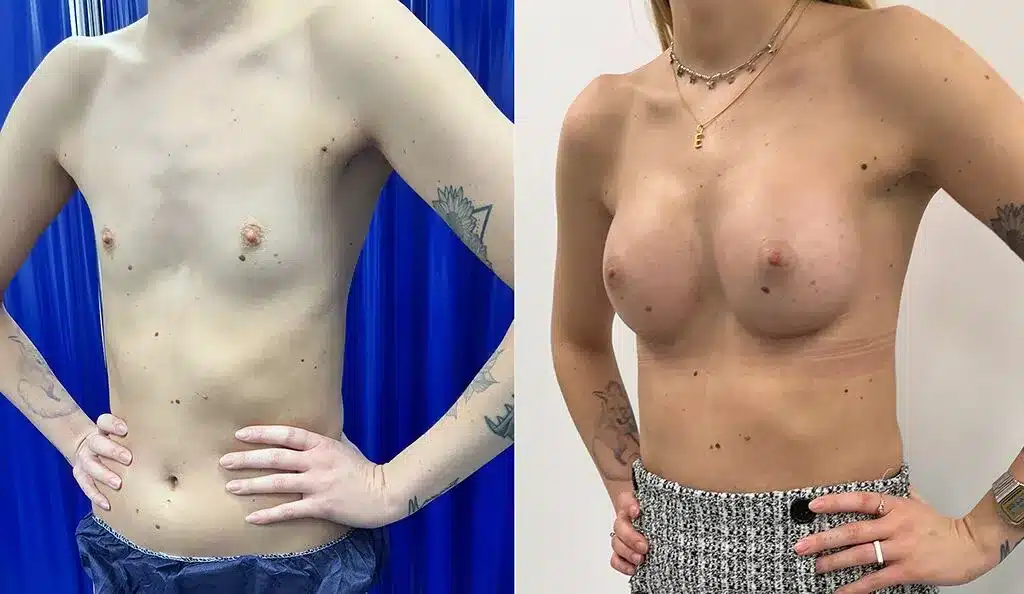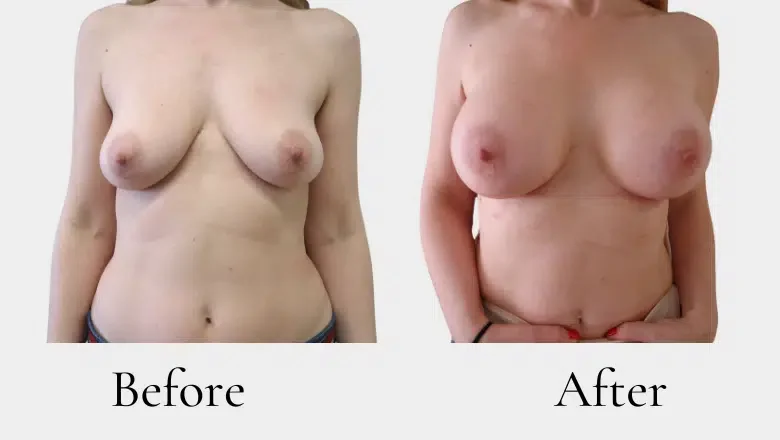When considering breast augmentation, many focus on the aesthetic outcomes without considering the physical implications of implant weight. The weight of breast implants varies significantly based on the size of the enhancement you choose. Additionally, differences in implant types and the manufacturing techniques of various companies such as Mentor and Motiva contribute to weight variations. These differences aren’t merely technical details; they can profoundly impact the surgical procedure and the following recovery process. Understanding the role of implant weight is essential for anyone considering this transformative surgery.
RELATED: Breast Implant Options
Typical Weights of Silicone and Saline Breast Implants
Two primary types of implants are commonly used: silicone and saline. While they may seem similar in size and appearance, there are subtle differences in their weights that potential patients should be aware of.
RELATED: How To Choose The Best Breast Implants
Silicone Breast Implants
Silicone breast implants are renowned for their natural feel and are a popular choice among many seeking augmentation. These implants tend to weigh slightly more than their saline counterparts, though the difference is generally minimal. To put this into perspective, each cubic centimetre (cc) of silicone gel used in an implant weighs approximately one gram. This means that a silicone implant with a volume of 200cc would weigh about 200 grams. If you’re considering a larger size, such as a 300cc implant, the weight would proportionally increase to around 300 grams.
It’s important to remember that implants are typically placed in both breasts during augmentation procedures. Therefore, the total added weight to your body would be double that of a single implant. So, if you opt for 200cc implants in both breasts, you would be adding approximately 400 grams to your overall body weight. While this might not seem significant, it’s a factor worth considering, especially if you lead an active lifestyle or have concerns about the additional weight on your chest and back.
Saline Breast Implants
Saline breast implants offer an alternative to silicone implants and are filled with a sterile saltwater solution. These implants are slightly lighter than silicone implants due to the lower saline density compared to silicone gel. Specifically, each cubic centimetre of saline solution weighs just under one gram. This means that a 200cc saline implant would weigh approximately 190 grams—slightly less than a silicone implant of the same volume.
Though the difference in weight between saline and silicone implants is modest, it might influence your decision if you’re sensitive to changes in weight or are considering larger implant sizes. For instance, over both breasts, the cumulative weight difference becomes more noticeable. A pair of 200cc saline implants would add around 380 grams to your body weight, compared to 400 grams for silicone implants of the same size.
RELATED: Silicone vs Saline Breast Implants
The Influence of Breast Implant Weight on Your Surgical Experience
The implant’s weight doesn’t just alter the aesthetic outcome; it also influences the surgical techniques used, the healing process, and the potential for scarring. By gaining insight into these factors, you can make a more informed decision and prepare adequately for your transformative journey.
Impact on Surgical Techniques
The weight of the implants you choose significantly determines the surgical approach your surgeon may adopt. Heavier implants often require additional support to ensure they settle correctly and maintain their position over time. In such cases, surgeons might opt to place the implant beneath the pectoral muscle—a method known as subpectoral placement. This technique provides extra support from the muscle tissue, which can be particularly beneficial for individuals with thinner breast tissue and skin. The muscle acts as a supportive sling, reducing the likelihood of implant movement or sagging, and contributes to a more natural contour.
On the other hand, lighter or smaller implants may not necessitate this additional support. These implants can often be placed above the muscle, referred to as prepectoral placement. This method involves less manipulation of the muscle tissue, potentially leading to a shorter operation time and a swifter initial recovery. Additionally, with smaller implants, there’s a reduced risk of complications such as rippling or visible edges, since the existing breast tissue can adequately cover and support the implant.
The decision between subpectoral and prepectoral placement isn’t solely based on implant weight; your surgeon will also consider factors like your anatomy, skin elasticity, and aesthetic goals.
Effects on Recovery Duration
The weight of your breast implants can influence not only the surgical procedure but also the length and nature of your recovery period. Heavier implants exert more pressure on the surrounding tissues and blood vessels during the healing process. This increased pressure can lead to more pronounced swelling and bruising, which may extend the time it takes for your body to fully recover. You might experience a greater degree of discomfort initially, and activities that involve chest movement could be restricted for a longer period.
RELATED: Recovery After Breast Augmentation Surgery – Top Tips
Recovery is a highly individual experience. Each person heals at their own pace, influenced by factors such as age, overall health, and adherence to postoperative care instructions. While heavier implants might introduce additional challenges, following your surgeon’s advice and allowing ample time for rest can facilitate a smoother recovery.
Choosing a highly experienced breast augmentation surgeon is crucial in optimising your healing process. A skilled surgeon understands the nuances of working with implants of various weights and sizes. Their expertise ensures that the implants are placed in a manner that minimises tissue trauma and promotes efficient healing. They can also provide tailored guidance on managing any discomfort and monitoring your progress throughout the recovery period.
Considerations for Scarring
Scarring is a natural aspect of any surgical procedure, and the weight of your implants can affect the appearance of these scars during the healing process. Heavier implants may place additional tension on the surgical incisions, especially in the early stages of recovery. This tension can potentially lead to thicker or more prominent scars if not properly managed.
Our specialist breast implant surgeons are adept at minimising scarring risks associated with heavier implants. They utilise advanced suturing techniques that support the incisions and distribute tension evenly. Throughout your follow-up appointments, they closely monitor the healing of your scars, providing interventions if necessary to ensure they fade effectively over time.
Moreover, we offer laser scar removal treatments to reduce the visibility of any post-surgical scarring further. This non-invasive procedure can significantly enhance the appearance of scars, helping you feel more confident about your results.
Choosing the Perfect Breast Implant Size
Selecting the right size for your breast implants is a pivotal step in your augmentation journey. It’s not merely about choosing a cup size; it’s about finding the ideal fit that complements your body and aligns with your aesthetic aspirations. This highly personalised process begins with a comprehensive consultation, where your individual needs and desires take centre stage.
Initial Consultation
The journey commences with an in-depth consultation at our clinic, where you’ll meet with an experienced breast augmentation surgeon. During this private meeting, the surgeon will engage in a thorough discussion to understand your aesthetic goals, personal preferences, and any concerns you may have about the procedure. This is your opportunity to express what you hope to achieve, whether enhancing volume, improving symmetry, or restoring fullness lost due to factors like ageing or pregnancy.
Your medical history plays a crucial role in planning your surgery. The surgeon will review your health background, including any previous surgeries or medical conditions, to ensure that breast augmentation is a suitable and safe option for you. They will also discuss the potential risks and benefits, providing you with all the information needed to make an informed decision.
Physical Examination and Body Proportions
After the initial discussion, a detailed physical examination assesses your breast tissue, skin quality, and overall body proportions. The surgeon will evaluate factors such as skin elasticity, nipple position, and the natural shape and size of your breasts. This assessment helps in determining the most suitable implant size and type that will achieve the desired outcome while maintaining a natural look and feel.
Your body’s unique proportions—including your height, weight, shoulder width, and hip measurements—are taken into account to ensure that the selected implants harmonise with your physique. The goal is to create a balanced silhouette that enhances your natural beauty without appearing disproportionate or artificial.
Customised Implant Selection
The surgeon will guide you through the options available, armed with a thorough understanding of your goals and physical attributes. This includes discussing the different types of implants—such as silicone gel or saline-filled—and their respective advantages. You’ll explore various implant sizes, shapes (round or teardrop), and profiles (the extent to which the implant projects from the chest) to find the combination that best suits your aspirations.
You may have the opportunity to try on sizer implants or use 3D imaging technology to visualise potential results. This interactive process allows you to see how different implant sizes and shapes could look on your body, helping you to make a confident choice. The surgeon’s expertise is invaluable here, as they can provide professional recommendations and answer any questions you might have.
























































